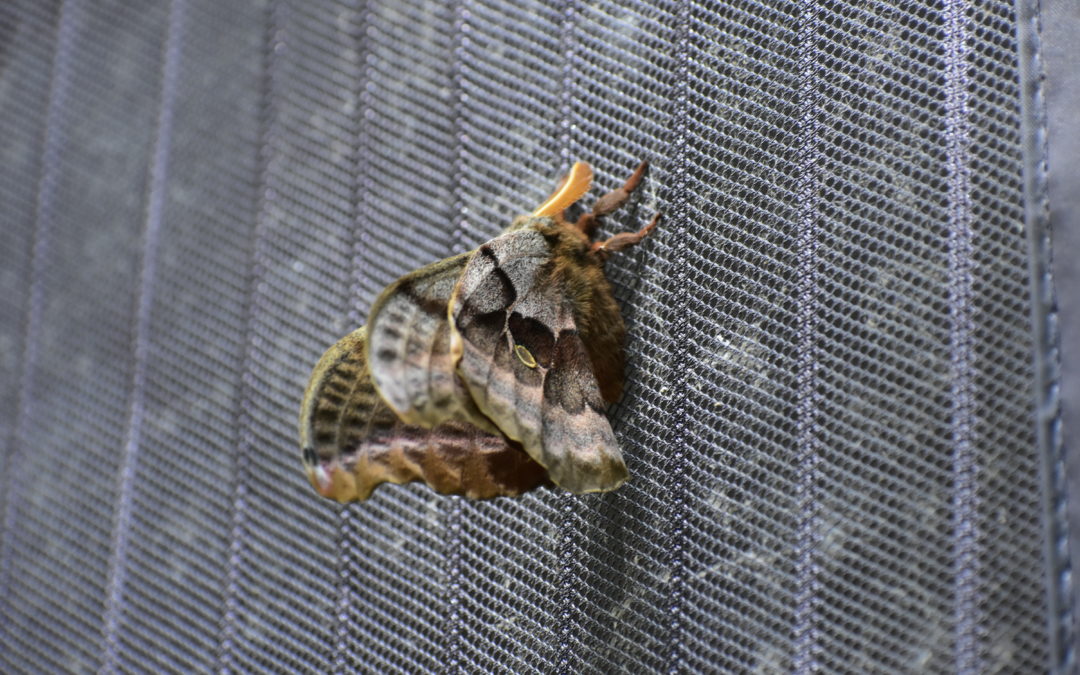Moths evolved long before butterflies; fossils of moths have been dated back 200 million years. Some scientists believe that moths evolved with flowering plants. But new studies suggest that they first developed their long tongue, or proboscis, to lap up sweet pollination drops from gymnosperms (imagine forests a of Gingko, Cycads, and Conifers), during the Jurassic period. Imagine moths fluttering around primeval grasslands and swamps inhabited by dinosaurs like Stegosaurus and Brachiosaurus, perhaps being hunted by bird-like Archeopteryx.
Butterflies, by contrast, have only existed for about 50 million years, and are believed to have evolved from day-flying moths attracted to the newly-evolving, nectar-producing flowering plants. Most modern moths (and butterflies) feed exclusively on plants as larvae (caterpillars), and also as adults. But there are exceptions, like moths that munch on mushrooms and lichens, or feed on leaf litter in the forest or feathers in birds’ nests. One group of moths in Africa, the Tineids, feed on keratin in the hooves and horns of dead mammals and the shells of tortoises. Here at home, the Sooty-winged Chalceola parasitizes the nests of Paper Wasps, laying eggs in the paper nest so that the caterpillars can feed on wasp larvae.
We typically imagine pollination of plants being done by bees. But many other insects, as well as bats and birds, serve a vital role in pollination. One study found that nocturnal moths visit more plant species than day-active bees do, making them important pollinators indeed, visiting flowers at night, after other pollinators have settled down for the night. Moths have wide ranging tastes in plants; while some species are generalists, others have evolved to rely on a single plant species or group of species, such as a unique species of Yucca moth for each species of Yucca. “Moth flowers” generally bloom at night, with pale-colored or white flowers that are heavily fragrant with a lot of diluted nectar. They typically bloom in clusters and provide a landing platform, as most moths aren’t able to hover while they feed. Some are morning glory, tobacco, and gardenia.Moths play a vital role in food webs and are an important food item for songbirds, mammals, and other insects. Caterpillars are the ideal baby bird food! They are important indicators of a healthy environment and ecosystem. The presence of moth diversity often indicates that the habitat is rich in other critters and a good place to live. In addition to their pollination services, and making caterpillars to feed baby birds, some moths play a key role in nutrient and carbon cycling – the caterpillars break apart coarse organic matter, enriching soils. A few species of moths have been imported as a biological control of noxious and/or invasive plant species, such as the Cinnabar Moth that feeds on Tansy Ragwort, the Poison Hemlock Defoliator, and the Double-lobed Moth feeds on invasive Reed Canary Grass.
Worldwide, there are 19,000 known species of butterflies, but there are an astounding160,000 species of moths, 12,000 or so of which are found in North America. According to Pacific Northwest Moths at Western Washington University, the Pacific Northwest is home to 1,200 known moth species. Different ecosystems are home to different species, as each tends to be reliant on specific host plants. Host plants are those plant species on which the mother moth lays her eggs, and upon which the caterpillars feed until they pupate after several weeks of eating. The places with the highest diversity of moth species are those in transitional areas between habitat types. For example, between a grassland and forest, or a suburban area and wetland. On my back porch, in a green oasis in the industrialized Kent Valley, I have logged 140 species of moths!
But what does that amount of moth diversity mean exactly…why do moths matter? Moths can be found in most habitats with some locations housing more than 400 species. They inhabit every kind of land-based ecosystem, as well as wetlands, ponds, and even peat bogs. Across the highest mountains, moths inhabit lichens, mosses, herbs and grasses; they live in forests, coasts, grasslands, wetlands, cliffs and front lawns. Name a habitat and moths will form part of how the ecosystem functions. Moths are incredibly important, both for their intrinsic value and the services they provide to our planet.
Join us at SHADOW on Saturday July 29, to celebrate National Moth Week! We will be attracting moths with special lights so that we can identify and count the number of species who call the bog and surrounding areas their home.
“Why moths matter, 28 July 2021, University of Auckland Faculty of Science, Environment, https://www.auckland.ac.nz/en/news/2021/07/28/why-moths-matter.html
“For The Love Of Moths”, Candace Fallon, July 14, 2021, Xerxes Society, https://xerces.org/blog/for-love-of-moths
Pacific Northwest Moths, Western Washington University, http://pnwmoths.biol.wwu.edu/



Recent Comments